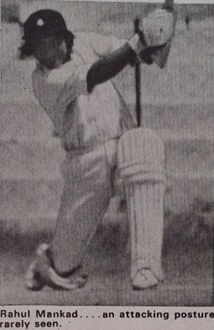No Point in Aping Others: A cricketer has to make a lasting impact on today’s cricketing scene; he has to pay personal attention to the theory and practice of cricket. Dedication and determination play an important part in the entire makeup. Mass coaching, I feel, will not fetch appreciable results. At the lower age levels, mass coaching may have some relevance, but at the higher levels, the players require nothing short of personal attention.
When you are looking after players of international stature, you must have the ability to convince them of the pros and cons of any particular problem and the ability to assess their merits and flaws and guide them suitably. In this respect, I have a great predecessor in Vasant Amladi, who is an expert in diagnosing and correcting the flaws in a player.
A common problem that a coach faces is that of tackling the boy who has some technical flaws ingrained in him that have gone undetected. How the coach modifies the technique without decreasing the effectiveness of the player will give you an idea of the true caliber of the coach. Many of our cricketers today get too tensed up and repress their natural ability because of muddled thinking—Rahul Mankad and Dilip Vengsarkar are a case in point.
Rahul ought to be indulging in stroke play more often than he does, because when he does that, he is a pleasing batsman to watch. I tell Dilip Vengsarkar that he can never be another Sunil Gavaskar. Because he is in far better sight while stroking the ball than while defending it. On a recent Rahul Mankad, an attacking posture is rarely seen.

On the tour, medium-pacer Madanlal inquired of his teammate, who was reading the weekly astrological forecast, to see when I would start hooking’. But for that flaw, Madanlal is one of our able batsmen.
But he takes his eyes off the ball the moment it is dug in, and that lack of confidence at not being able to hook it consistently plays upon his mind. The greatest quality one must have is the ability to adapt to varying situations.
In today’s cricket application, imitation has been substituted by imitation to some extent. After watching Alan Knott on Indian grounds in 1972, one saw wicketkeepers copying his mannerisms, little realizing that they had no use for them; we as Indians are naturally far more supple.
Alan Knott in particular, is prone to stiffness; hence, he keeps limbering up to keep himself flexible. The bat-pad technique was also needlessly copied by some of our batsmen. In England, it was modified by some top-class batsmen to counter the spinners since they did not read the spinners at the time of delivery. Even then, the pad was, at best, the second line of defense. The bat must precede the pad in your play at all times, the same is true with tracksuits.
They are used extensively abroad by players not only to keep themselves warm but also to keep their laundry expenses low. In our country, they have little use, at least on the first count, yet some of our players ape this practice. Personally, I think a tracksuit on a cricket field is certainly incongruous.
The basis of application is observation. As a student of the game, I was surprised to see Rohan Kanhai playing Denis Lillee at his fastest off the front foot more often than others. Then I realized that by doing so, he was minimizing the width of the swing and thus countering his menace. And how’s this for observation? It was an old Australian lady who pointed out one of the minimal flaws in Sunil Gavaskar’s technique.
We were watching “Sunny” try to hook and miss a Denis Lillee bouncer. The lady who is Alan Turner’s mother (Alan Turner, the Australian opening batsman) remarked, “Sunil is just like my son. He does not finish the hook underneath the shoulder. That’s why he plays it in the air”. An essential part of coaching is follow-up. It is said that a coach may sometimes not get an opportunity to watch the boy whom he has coached.
All the cream of the city’s talent must be brought together. A good follow-up of the Tairsee nets at P. J. Hindu Gymkhana, Bombay, would be to make the best ten boys members at nominal rates; incidentally, this suggestion is being acted upon. Yes, action is what we want if we are to proceed in the right direction.
